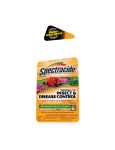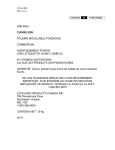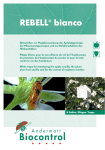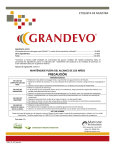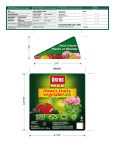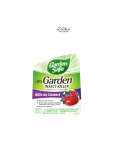Transcript
STOP. READ ENTIRE LABEL BEFORE USE. DIRECTIONS FOR USE It is a violation of Federal law to use this product in a manner inconsistent with its labeling. READ ENTIRE LABEL BEFORE EACH USE. USE INFORMATION Garden Safe® Brand Garden Dust Insect Killer may be used throughout the growing season, or as a pre-harvest treatment. It is acceptable for use up to the day of harvest on edible plants. Apply when insects first appear before damage from feeding occurs. Contact insects directly whenever possible. Wear household latex or rubber gloves; use a dust applicator as available. Apply dust uniformly to upper and lower leaf surfaces with a thin, even film of dust. Apply when air is calm to avoid drift and contact with eyes and skin. Allow dust to settle in treated areas before re-entering. Do not apply when bees are active in the area. Do not apply if rain is expected within 24 hours. Wash hands thoroughly after handling and before eating or smoking. Do not allow dust to wind drift to non-target plants or water supplies. Start applying at the farthest corner of the treatment area and work backward to avoid contact with dusted surfaces. Wash all fruits and vegetables before eating. PHYTOTOXICITY NOTE: Plant safety is an important consideration when using insecticides. However, it is not possible to evaluate the potential adverse effects of this product on numerous plant varieties that may react differently to insecticides in different growth stages or under varying environmental conditions. Before making widespread applications of this product, treat a limited number of plants and observe for adverse effects over a one- to 10-day period. This product must come into contact with insects in order to kill them. Coverage of the target insect is vital to achieving good performance. Apply this product to cover upper and lower surfaces of leaves stems and flowers with a thin, even film of dust. Apply when insects or insect damage first appears. HOME GARDENS: This product is not for use on plants being grown for sale or other commercial use. WHEN TO APPLY: Use at first signs of insect infestation, preferably before damage and feeding occurs. Can be used up to day before harvest. For most effective results, follow directions for specific use areas. Avoid contamination of food and feedstuffs. FOR BEST RESULTS: Apply in the twilight hours of the evening or just before sunrise to avoid possible harm to honey bees. Honey bees normally forage during the daylight hours, when the temperatures reach or exceed 55°F. Contact as many insects as possible when applying. Apply to provide thorough coverage of foliage and upper and lower leaf surfaces. USE RESTRICTIONS: Do not make applications during rain. Aerial applications are prohibited. Do not water the treated area to the point of runoff. Do not reapply within 3 days except under extreme pest pressure. In case of extreme pest pressure, do not reapply within 24 hours. Do not apply more than 1 time per day. Do not apply the maximum application rate more than 10 times per growing season. Applications with power duster equipment are prohibited. PRE-HARVEST APPLICATION TO GARDEN CROPS - USE RESTRICTIONS: The maximum application rate per application is 4 ounces per 208 square feet or 1 ounce per 52 square feet. The maximum application rate is equivalent to 0.05 pounds of pyrethrins per acre. VEGETABLE CROPS • Edible-podded legume vegetables including: snap bean, wax bean, yardlong bean, Jack bean, edible-pod pea, snow pea, and sugar snap pea. Dried shelled legume vegetables including: field bean, kidney bean, lima bean (dry), navy bean, pinto bean, adzuki bean, blackeyed pea, cowpea, mung bean, Southern pea, and dry lentil. Cole crops including: broccoli, Brussel sprouts, cabbage, Chinese cabbage, Chinese broccoli (on gai Ian, white flowering), cauliflower, collards, kale, kohlrabi, and mustard greens. Cucurbit vegetables including: balsam pear - bitter melon, Chinese waxgourdChinese preserving melon, citron melon, cucumber, gherkin, edible gourds, honeyballs, honeydew melons, mango melons, muskmelon, Persian melon, pumpkins, cantelope, casaba, crenshaw, zucchini, squash and watermelon (including hybrids). Fruiting vegetables (except cucurbits) including: eggplants, tomatoes and bell peppers (including green peppers). Leafy vegetables (except brassica) including: amaranth, arugula, celery, chervil, corn salad, chrysanthemum (edible-leaved and garland), cress (garden and upland), dandelion, dock, endive, fennel, lettuce, parsley, purslane (garden and winter), radicchio, rhubarb, spinach and Swiss chard. Onions (dry bulb and garlic), corn (sweet and pop) and rice, root and tuber vegetables including: artichokes, carrots, garden beets, potatoes, radishes, rutabagas and turnips. Asparagus, okra, grapes, and strawberries, and berries including: blackberries, blueberries, boysenberries, loganberries, dewberries, and raspberries (black and red). Herbs and spices including: basil, chives, clove, cilantro, dill, fennel, ginger, mint, nutmeg, oregano, parsley, rosemary, saffron, sage, savory, tarragon and thyme. INSECTS KILLED: ON VEGETABLES & MELONS: aphids, armyworms, artichoke plume moth, asparagus beetle, cabbage looper, Colorado potato beetle, com earwom, corn rootworm (adult), cucumber beetle (adult), cutworms, diamondback moth, European corn borer, flea beetles, hornworms, imported cabbage looper, leaf hoppers, leaf miners, melon worm, onion maggot (adult), onion thrips, pepper weevil, pickleworm, plantbugs (including lygus, squash, and stink bugs), potato psyllid, potato tuberworm, rindworm, squash vine borer, tomato fruitworm, and tomato pinworm. APPLICATION TO ROSES AND ORNAMENTAL FLOWERS - USE RESTRICTIONS: 1 ounce dust treats 5 rose bushes. The maximum application rate per application per day is 8 ounces per 200 square feet or 2 ounces per 50 square feet. The maximum application rate is equivalent to 0.0001 pounds of pyrethrins per 50 square feet. ROSES AND ORNAMENTAL FLOWERS INCLUDING: African violets, ageratum, aster, azalea, begonia, camellia, carnation, chrysanthemum, coleus, common snowberry, crassula, dahlias, delphinium, exacum, fuchsia, geranium, gladiolus, gold bells, hypoestes, marigold, orchid, palm, pansy, petunia, philodendron, poinsettia, rhododendron, rose, snapdragon, stocks, taxus wax plant, wandering Jew, and zinnias. APPLICATIONS TO ORNAMENTAL EVERGREENS, BUSHES, TREES, SHADE TREES AND SHRUBS - USE RESTRICTIONS: The maximum application rate per application per day is 8 ounces per 200 square feet or 2 ounces per 50 square feet. The maximum application rate is equivalent to 0.0001 pounds of pyrethrins per 50 square feet. When treating trees, shrubs and similar plants, treat the trunk, the base of the trunk and the critical root zone. Treat the tree crotch, knotholes, wounds and other areas where insects may harbor. Allow dust to settle in treated areas before re-entering. Do not water or irrigate immediately following treatment. ORNAMENTAL TREES AND SHRUBS INCLUDING: alder, ash, Arizona cypress, azalea, birch, box elder, boxwood, cherry (ornamental), common ninebark, conifers, cottonwood, crepe myrtle, dogwood, Douglas fir, elm, English ivy, euonymous, fir, grape vines (ornamental), hawthorn, Holly, honeysuckle, hydrangea, juniper, laurel, lilac, locust, maple, mimosa, mock orange, nannyberry, oak, palm pea shrub, pine plum, poplar, spruce, sycamore, tulip poplar, weeping fig, and willow. INSECTS KILLED: ON AND AROUND ORNAMENTAL ROSES, FLOWERS, EVERGREENS, TREES, SHADE TREES, BUSHES AND SHRUBS: adelgids, ants (excluding pharaoh and carpenter ants), aphids, apple aphids, apple maggots, armyworms, Asian cerambycid beetles, Asian lady beetles, Asian pine tip moths, Australian sod flies, azalea leafminers, bagworms, beetles, billbugs, birch leafminers, black fungus beetles, black turfgrass ataenius (adult), black turpentine beetles, black vine weevils, blister beetles, blow flies, blue grass billbug (adult), boll weevils, boxelder bugs, boxwood leafminers, brown dog ticks, brown spider beetles, brown spruce longhorn beetles, browntail moths, budworms, cadelles, California oakworms, campylomma bugs, cankerworms, carrion beetles, catalpa sphinx, caterpillar ants, caterpillars (including tent), catorama beetles, centipedes, chinch bugs, chrysanthemum leaf miners, cicadas, clearwing borers, climbing cutworms, clover mites, clover weevils, cockroaches, codling moths, cone beetles, cone worms, conifer spider mites (adult), corn borers, corn earworms, cottonwood borers, cottonwood leaf beetles, crane flies, crickets, cutworms (exposed), dermestid beetles, diamondback larvae, dichondra flea beetles, dingy cutworm adult, Douglas fir midge, Douglas fir tussock moth, dung beetles, earwigs, Eastern tent caterpillars, elm leaf aphids, elm spanworms, elmleaf beetles, emerald ash borer, eriophyid mites, European pine shoot moths, European pine tip moths, European red mites, fall armyworms, fall cankerworms, fall webworms, field crickets, firebrats, fireworms, flatheaded borers, fleas, flea beetles, forest tent caterpillars, fruit flies, fruittree leafrollers, fuller rose beetles, fungus beetles, fungus gnats, gall midges, gall wasps, German cockroaches, giant root aphids, glassy-winged sharpshooters, ground beetles, grasshoppers, green apple aphids, green bugs, greenhouse thrips, greenhouse whiteflies, greenstriped mapleworms, grubs, gypsy moths (adult and larvae), hackberry nipplegall makers, hairy fungus beetles, harlequin bugs, heliothis spp., Holly budmoths, Holly leafminers, hoplia beetles, hornworms, hyperodes weevils (adult), inchworms, iris borer, jackpine budworms, Japanese beetles, Jeffery pine needleminers, June beetles, katydids, lace bugs, lawn moths (sod webworms), leaf tiers, leafhoppers, leafminers, leafrollers, lesser peach tree borers, lice, locust borers, loopers, love bugs, lygus bugs, madrone thrips, maggots, maple leafcutters, McDaniel spider mites, mealybugs, millipedes, mimosa webworms, plant mites, mole crickets (nymphs and young adults), moths murmidius beetles, mushroom flies, Nantucket pine tip moths, oak leaf skeletonizers, oak leafminers, oakworm complex, oleander caterpillars, olive ash borers, orange tortrix, orangestriped oakworms, Pacific mites, Palmetto bugs, peach twig borer, pear psylla, pear sawflies, pearleaf blister mites, periodical cicadas, phorid flies, pillbugs, pine bark beetles, pine engraver, pine sawflies, pine spittlebugs, pink scavenger caterpillars, pinworms, pitch pine tip moths, plant bugs, plum curculia, poinsettia hornworms, ponderosa pine needle miner, psyllids, puss caterpillars, raspberry horntail, red gum lerp psyllid, red lilly beetles, red oak borers, redbanded leafrollers, redhumphed oakworms, rootworms, rose aphids, rose chafers, rose curculios, rose leafhoppers, rose slugs, rosy apple aphids, royal palm bugs, saddled prominent caterpillar, sawflies (exposed), scale (crawlers), sciarid flies, seedbugs, silverfish, small fruit flies, Southern pine beeltes, Southern red mite (adult), Southern chinch bugs, sowbugs, spider beetles, spider mites, spiders, spiny elm caterpillars, spittlebugs, springtails, spruce budworms, spruce needleminers, stalk borers, strawberry mites, subtropical pine tip moths, sweet potato whiteflies, sycamore leaf beetle, tarnished plant bug, tent caterpillars, thorn bugs, thrips (exposed), ticks, trogoderma beetles, two-spotted spider mites, viburnum leaf beetles, walnut caterpillars, wasps, waterbugs, webworms (including garden, sod, tropical), weevils, western flower thrips, Western hemlock loopers, Western pine tip moth, Western spruce budworms, white apple leafhoppers, white apple leafrollers, white grubs (Japanese beetle, European chafer, Southern chafer), willow leaf beetles, wolly apple aphids, and yellow poplar weevils. Contains Pyrethrins – a Insecticide derived from Chrysanthemum flowers Brand STORAGE AND DISPOSAL Do not contaminate water, food, or feed by storage or disposal. PESTICIDE STORAGE: Keep this product in its tightly closed original container, when not in use. Store in a cool, dry, well-ventilated (preferably locked) area that is inaccessible to children and animals. Store away from food and pet food. PESTICIDE DISPOSAL AND CONTAINER HANDLING: Nonrefillable container. Do not reuse or refill this container. If empty: Place in trash or offer for recycling if available. If partly filled: Call your local solid waste agency for disposal instructions. Never place unused product down any indoor or outdoor drain. PRECAUTIONARY STATEMENTS HAZARDS TO HUMANS AND DOMESTIC ANIMALS CAUTION. Harmful if swallowed or absorbed through the skin. Avoid contact with skin, eyes or clothing. Wash hands thoroughly with plenty of soap and water after handling and before eating, drinking, chewing gum, using tobacco or using the toilet. Remove and wash contaminated clothing before reuse. Prolonged or frequently repeated skin contact may cause allergic reactions in some individuals. ENVIRONMENTAL HAZARDS • This pesticide is toxic to aquatic organisms, including fish and invertebrates. To protect the environment, do not allow pesticide to enter or run off into storm drains, drainage ditches, gutters or surface waters. Applying this product in calm weather when rain is not predicted for the next 24 hours will help to ensure that wind or rain does not blow or wash pesticide off the treatment area. This product is highly toxic to bees exposed to direct treatment on blooming crops or weeds. Do not apply this product or allow it to drift to blooming crops or weeds while bees are actively visiting the treatment area. PHYSICAL OR CHEMICAL HAZARDS • Do not use or store near heat or open flame. FIRST AID IF ON SKIN OR CLOTHING: • Take off contaminated clothing. • Rinse skin immediately with plenty of water for 15-20 minutes. • Call a poison control center or doctor for treatment advice. IF SWALLOWED: • Call a poison control center or doctor immediately for treatment advice. • Have person sip a glass of water if able to swallow. • Do not induce vomiting unless told to do so by a poison control center or doctor. • Do not give anything by mouth to an unconscious person. Have the product container or label with you when calling a poison control center or doctor, or going for treatment. For additional information on this pesticide product (including health concerns, medical emergencies or pesticide incidents), you may call 1-800-257-3379. NOTICE: Buyer assumes all responsibility for safety and use not in accordance with directions. Questions or Comments? Call 1-800-257-3379 or visit our website at www.gardensafe.com The Garden Safe® Promise • Satisfaction guaranteed or your money back! If you apply Garden Safe® Brand Garden Dust Insect Killer as directed and you are not completely satisfied, send proof of purchase from this package and the original cash register receipt to the address below. We will refund the purchase price you paid. Distributed by Spectrum Group Division of United Industries Corporation PROOF OF PURCHASE PO Box 142642, St. Louis, MO 63114-0642 EPA Reg. No. 1021-2564-8845 EPA Est. Nos. 39578-TX-1 AM , 69208-MO-1 AO , 89287-KS-1 DA , 89287-KS-2 DC , 9688-MO-1 U , 11623-GA-3 CN Circled letter is first letter of lot number. 17-15073 © 2014 FPO UPC 0 72845 93199 3 Fast Acting Can Be Used Up Until The Day Before Harvest Kills 250 Listed Insects Use On Home Garden Fruits, Roses, Vegetables & Ornamental Plants ACTIVE INGREDIENTS: Pyrethrins, a botanical insecticide.....0.10% OTHER INGREDIENTS ........................99.90% 100.00% 0.001 lbs. active ingredient per lb. of product KEEP OUT OF REACH OF CHILDREN CAUTION See back for additional precautionary statements. Net Wt 1 lb (16 oz / 453 g)


